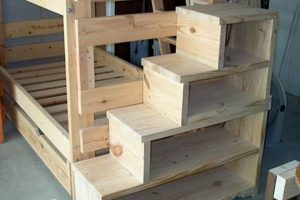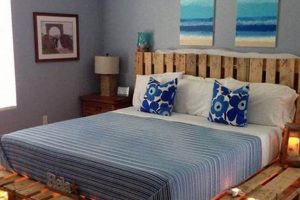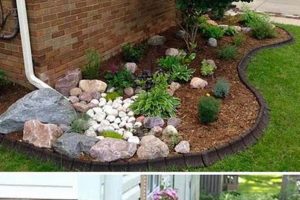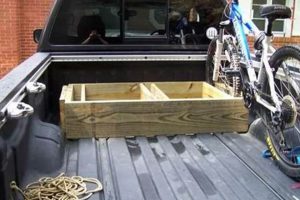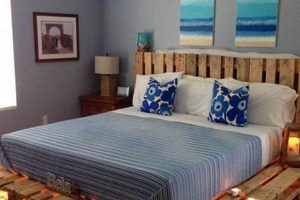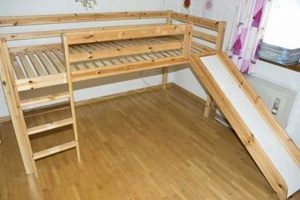Protective structures constructed by individuals for elevated planting areas offer a means to shield vegetation from various environmental factors. These customized shields, often crafted from readily available materials, aim to modulate temperature, deter pests, and manage precipitation levels affecting plant growth. Common examples include frames covered with netting to exclude insects, or transparent plastic sheeting used to create miniature greenhouse environments.
The use of such protective elements provides several advantages. They can extend the growing season, allowing for earlier planting and later harvesting of crops. Further, they minimize damage from harsh weather, such as frost, hail, or excessive sunlight. Historically, rudimentary forms of plant protection, like cloches or cold frames, have been employed for centuries, demonstrating the long-standing recognition of the value in safeguarding cultivated plants.
The following sections will delve into the different types of these covers, explore suitable materials for their construction, provide step-by-step guides for several designs, and discuss considerations for maintenance and optimal usage.
Construction Considerations
The following points offer valuable insights for successful construction and utilization of protective structures for elevated planting areas. Careful adherence to these tips will maximize the benefits derived from these garden enhancements.
Tip 1: Material Selection: Prioritize durable and weather-resistant materials. Untreated wood is susceptible to rot; consider treated lumber or naturally rot-resistant options like cedar. Choose UV-resistant plastics for prolonged lifespan.
Tip 2: Frame Stability: Ensure the frame is structurally sound to withstand wind and snow loads. Reinforce joints with screws and metal brackets. Consider anchoring the frame to the raised bed for added stability.
Tip 3: Ventilation Provision: Adequate airflow is crucial to prevent overheating and excessive humidity. Incorporate vents or adjustable panels that can be opened during warmer periods.
Tip 4: Pest Exclusion: When employing netting, select a mesh size appropriate for the target pests. Secure the netting tightly to the frame to eliminate entry points.
Tip 5: Access Facilitation: Design the cover with easy access for planting, weeding, and harvesting. Hinged panels or removable sections can greatly improve usability.
Tip 6: Light Transmission: Opt for transparent or translucent materials to maximize light penetration, which is essential for plant growth. Clean the cover regularly to remove accumulated dirt and debris.
Tip 7: Drainage Considerations: Ensure rainwater runoff is effectively managed to prevent waterlogging within the raised bed. Slope the cover slightly or incorporate drainage holes.
These considerations highlight the importance of careful planning and execution. By addressing these factors, one can create effective and long-lasting protective structures for elevated planting areas.
The subsequent section will address common challenges encountered during the construction process and offer troubleshooting advice.
1. Frame materials
The structural integrity and longevity of protective structures for elevated planting areas are intrinsically linked to the selection of appropriate framing materials. The chosen material directly impacts the cover’s ability to withstand environmental stressors, resist degradation, and provide stable support for covering materials.
- Wood Selection and Treatment
Wood is a commonly employed material due to its affordability and ease of workability. However, untreated wood is susceptible to rot, insect infestation, and weathering, drastically reducing the lifespan of the cover. Pressure-treated lumber offers enhanced resistance to decay, but concerns regarding chemical leaching into the soil may necessitate the use of liners. Alternatively, naturally rot-resistant woods, such as cedar or redwood, provide a durable and environmentally conscious option, albeit at a higher initial cost.
- Metal Framing Options
Metal framing, typically constructed from steel or aluminum, offers superior strength and resistance to weathering. Steel requires protective coatings to prevent rust, while aluminum is naturally corrosion-resistant. Metal frames are particularly well-suited for larger or more permanent covers that require significant structural support. The higher initial cost of metal may be offset by its extended lifespan and minimal maintenance requirements.
- PVC and Composite Materials
PVC pipes and composite lumber offer lightweight and weather-resistant alternatives for framing. PVC is relatively inexpensive and easy to assemble, making it suitable for smaller, temporary covers. Composite lumber, made from recycled plastic and wood fibers, provides enhanced durability and resistance to rot and insect damage. While these materials offer advantages in terms of maintenance and weight, they may lack the structural strength of wood or metal, limiting their suitability for larger or more complex designs.
- Joint Construction and Hardware
Regardless of the framing material selected, proper joint construction and hardware are essential for ensuring the stability and longevity of the cover. Securely fastening joints with screws, bolts, or specialized connectors will prevent the frame from racking or collapsing under stress. The use of rust-resistant hardware is crucial for preventing corrosion and maintaining the structural integrity of the assembly. Consider the specific load-bearing requirements of the cover when selecting appropriate joint construction methods and hardware.
The selection of framing materials fundamentally determines the durability, cost-effectiveness, and overall performance of protective structures for elevated planting areas. A careful evaluation of the specific requirements of the garden, the local climate, and available budget is essential for making an informed decision that will ensure the long-term success of the gardening endeavor.
2. Covering options
The effectiveness of protective structures for elevated planting areas is significantly determined by the selection of appropriate covering materials. The covering directly influences light transmission, temperature regulation, moisture control, and pest exclusion, all of which are critical factors for plant health and productivity. Choosing the correct covering material is not merely an aesthetic decision but a functional imperative that dictates the microclimate within the raised bed. For instance, polyethylene film offers a cost-effective solution for creating a greenhouse environment, trapping heat and extending the growing season. Conversely, shade cloth provides protection from intense sunlight, preventing scorching and water loss during hot summer months. These choices have a direct causal impact on plant growth.
Beyond polyethylene and shade cloth, diverse covering options cater to specific needs. Insect netting, for example, physically excludes pests, minimizing the need for chemical interventions. Row covers, made from lightweight spun-bonded fabric, provide protection from frost and wind while allowing air and moisture to permeate. Rigid materials like polycarbonate panels offer increased durability and impact resistance, suitable for long-term structures intended to withstand harsh weather conditions. In practical application, a gardener in a region with unpredictable spring frosts might opt for a combination of polyethylene film and row covers, providing both heat retention and frost protection during vulnerable periods. A market gardener focusing on organic practices would prioritize insect netting to safeguard crops from pests without relying on synthetic pesticides.
In summary, the selection of covering materials is a vital aspect of constructing functional protective structures for elevated planting areas. The choice must align with the specific environmental challenges and cultivation goals of the garden. While affordability and ease of installation are important considerations, the primary focus should remain on selecting materials that effectively modulate the microclimate and safeguard plants from detrimental external factors. Ignoring the specific needs of the plants and environment will likely undermine the entire purpose of the protective structure.
3. Ventilation needs
Ventilation is a crucial design consideration for protective structures on elevated planting areas. Adequate airflow mitigates issues arising from trapped humidity and heat, which can negatively impact plant health and overall productivity.
- Temperature Regulation
The primary function of ventilation is to regulate the internal temperature within the covered area. Without sufficient airflow, enclosed spaces can experience rapid temperature increases, particularly under direct sunlight. Excessive heat can cause plant stress, inhibit photosynthesis, and even lead to plant death. Strategically placed vents, either manually adjustable or automated, allow for the expulsion of hot air and the introduction of cooler ambient air. A practical example involves using hinged panels on the sides of a polytunnel, which can be opened during the day to prevent overheating and closed at night to retain warmth.
- Humidity Control
Elevated humidity levels create a conducive environment for fungal diseases and other pathogens. Plants transpire, releasing moisture into the air, which can become trapped within enclosed structures. Ventilation facilitates the removal of excess humidity, reducing the risk of disease outbreaks. This is particularly important in humid climates where naturally high moisture levels exacerbate the problem. For instance, incorporating mesh-covered openings at the top of a cold frame allows for continuous air circulation, preventing moisture buildup and minimizing the likelihood of fungal infections like powdery mildew.
- Pollination Enhancement
While some protective structures are designed to exclude pests, they can also inadvertently restrict access for pollinators such as bees and butterflies. Ventilation can indirectly enhance pollination by providing entry points for these beneficial insects. Furthermore, airflow can help to disperse pollen within the covered area, improving fruit set in self-pollinating plants. One strategy is to create larger, easily accessible vents during the flowering period to encourage pollinator activity.
- Structural Integrity
In addition to its direct effects on plant health, ventilation can also contribute to the structural integrity of the protective cover itself. Airflow reduces the build-up of pressure from wind, preventing damage or collapse, especially in larger structures like greenhouses. Properly designed ventilation systems can help equalize the pressure inside and outside the cover, minimizing stress on the frame and covering materials. This is particularly important in regions prone to strong winds, where adequate ventilation can significantly extend the lifespan of the structure.
Effective integration of ventilation solutions is thus an indispensable aspect of designing and constructing protective structures for elevated planting areas. The specific ventilation requirements will vary depending on the local climate, the type of plants being grown, and the design of the cover itself. Implementing appropriate ventilation strategies ensures a healthy growing environment and maximizes the benefits derived from these garden enhancements.
4. Pest exclusion
Pest exclusion is a primary function of protective structures on elevated planting areas. Implementing effective pest control strategies at the outset of construction offers a sustainable means of mitigating damage to crops, reducing reliance on chemical interventions, and maximizing yields.
- Physical Barriers
The construction of physical barriers forms the cornerstone of pest exclusion in elevated planting areas. Fine mesh netting, securely attached to a sturdy frame, prevents the entry of flying insects, such as aphids, whiteflies, and cabbage moths, which can decimate susceptible crops. The mesh size must be sufficiently small to exclude target pests while still allowing adequate airflow and light penetration. For example, a row cover made of tightly woven fabric effectively excludes flea beetles from brassica crops like kale and broccoli.
- Material Selection and Construction Techniques
The materials and construction techniques employed directly impact the effectiveness of pest exclusion. Gaps or openings in the structure compromise its integrity, providing entry points for pests. Durable, weather-resistant materials, properly sealed at joints and seams, are essential for maintaining a robust barrier. Burying the edges of the netting or attaching it to a solid base prevents pests from burrowing underneath. An example would be using PVC pipe as a frame, carefully sealing the mesh netting to the pipe with durable tape or specialized fasteners.
- Integrated Pest Management (IPM) Compatibility
Protective structures facilitate the implementation of Integrated Pest Management (IPM) strategies. By creating a controlled environment, gardeners can more easily monitor pest populations and apply targeted interventions when necessary. This reduces the need for broad-spectrum insecticides, which can harm beneficial insects and disrupt the ecosystem. For instance, sticky traps placed within the covered area can effectively monitor insect activity and provide an early warning of pest infestations, enabling prompt action to be taken.
- Crop Rotation and Companion Planting Synergies
The benefits of protective structures can be further enhanced by incorporating crop rotation and companion planting strategies. Rotating crops within the raised beds helps to disrupt pest life cycles, while planting repellent herbs, such as basil or marigolds, can deter pests from entering the covered area. For instance, planting basil alongside tomatoes under netting can help to repel tomato hornworms and other pests that commonly attack tomato plants. The synergy between these techniques and physical exclusion further strengthens pest management efforts.
Effective pest exclusion within elevated planting areas requires a comprehensive approach that combines robust physical barriers with complementary pest management strategies. By carefully selecting materials, employing sound construction techniques, and integrating IPM principles, gardeners can minimize pest pressure, reduce reliance on chemical interventions, and promote healthy, productive crops.
5. Winter protection
Protective structures for elevated planting areas play a critical role in winter protection. The primary function is to shield plants from the detrimental effects of freezing temperatures, harsh winds, and heavy snowfall. A well-designed cover minimizes frost damage, reduces desiccation caused by wind exposure, and prevents physical damage from accumulated snow. These structures effectively create a microclimate within the raised bed, moderating temperature fluctuations and prolonging the growing season for cold-hardy crops or ensuring the survival of overwintering perennials. For example, a simple cold frame constructed from salvaged wood and covered with polyethylene film can raise the internal temperature of a raised bed by several degrees, protecting sensitive plants from light frosts. Furthermore, a sturdy frame covered with burlap or landscape fabric can act as a windbreak, preventing the drying out of evergreen shrubs.
The selection of appropriate materials and construction techniques is paramount for effective winter protection. Insulated covers, incorporating materials such as bubble wrap or straw bales, provide enhanced thermal resistance, maintaining warmer soil temperatures and reducing the risk of root freezing. Proper ventilation is also crucial to prevent the buildup of moisture, which can lead to fungal diseases and root rot during periods of thaw. The design should also account for snow load, ensuring the structure is robust enough to withstand the weight of accumulated snow without collapsing. As an example, a high tunnel constructed from metal hoops and covered with a double layer of polyethylene can provide significant winter protection for vegetable crops, allowing for harvests even in colder climates. The air gap between the two layers of polyethylene acts as an insulator, further reducing heat loss.
In conclusion, winter protection is an indispensable consideration in the design and utilization of protective structures for elevated planting areas. By carefully selecting materials, employing sound construction techniques, and addressing factors such as insulation, ventilation, and snow load, gardeners can effectively mitigate the challenges posed by winter weather, extending the growing season and safeguarding valuable plants. The success of these protective measures directly translates to increased yields, reduced plant losses, and a more resilient garden ecosystem. The effectiveness of these strategies needs to be considered at the designing phase.
6. Water management
Effective protective structures for elevated planting areas necessitate careful consideration of water management, as the covers directly impact both water input and output. A poorly designed cover can lead to either waterlogging or insufficient irrigation, both detrimental to plant health. The cover’s slope and material composition dictate rainwater runoff patterns, influencing the water available to the soil. For instance, a flat, impermeable cover will prevent rainwater from reaching the plants, requiring alternative irrigation methods. Conversely, a cover with inadequate drainage can cause water to pool around the base of plants, increasing the risk of root rot. Therefore, water management is not an independent element but an intrinsic component of successful cover design and implementation.
Several strategies can be employed to optimize water management within protected raised beds. Sloping the cover encourages runoff and prevents water accumulation. Incorporating gutters and downspouts allows for the collection and redirection of rainwater, which can then be used for irrigation. Permeable covering materials, such as horticultural fleece, allow rainwater to reach the soil while still providing protection from frost or pests. Drip irrigation systems, installed beneath the cover, deliver water directly to the root zone, minimizing water loss through evaporation. In practice, a gardener might use a combination of sloping the cover to direct rainwater away from the structure, installing a drip irrigation system for consistent watering, and using permeable row covers during periods of light frost.
Proper water management within protected raised beds represents a critical intersection of design and horticultural practice. A clear understanding of how the cover interacts with water input and output, combined with the implementation of appropriate strategies, ensures optimal plant health and productivity. Challenges in water management often stem from neglecting the specific water needs of the plants, failing to adapt irrigation practices to changing weather conditions, or using inappropriate covering materials. The successful integration of water management principles ultimately contributes to the long-term sustainability and efficiency of elevated planting areas.
7. Accessibility
The ease with which individuals can interact with raised garden beds is significantly influenced by the design and construction of protective covers. These structures, intended to shield plants from environmental factors, can inadvertently create barriers to access if not carefully planned.
- Height and Reach Considerations
The height and reach required to access plants within a covered raised bed are crucial determinants of accessibility. Covers that are too tall may necessitate reaching over or climbing, posing challenges for individuals with limited mobility or upper body strength. Conversely, covers that are too low can restrict access for individuals who use wheelchairs or have difficulty bending. Designs that incorporate adjustable height features or removable sections can enhance accessibility for a wider range of users.
- Doorways and Openings
The size and placement of doorways and openings within a covered raised bed directly impact accessibility for individuals with mobility aids. Narrow doorways or awkwardly positioned openings can impede entry and maneuverability. Wide doorways, ramps, or other assistive features can facilitate access for wheelchair users and individuals with other mobility limitations. The design should also consider the ease of opening and closing mechanisms, ensuring that they are operable with minimal effort.
- Pathways and Clearance
The design of pathways and clearance around the covered raised bed is essential for ensuring accessibility. Narrow or obstructed pathways can hinder access for individuals with mobility aids or visual impairments. Wide, smooth pathways, free of obstacles, facilitate maneuverability and reduce the risk of accidents. Adequate clearance around the perimeter of the structure allows for comfortable movement and access to all areas of the garden bed.
- Material Selection and Construction Techniques
The materials and construction techniques used in the creation of protective covers influence their overall weight and ease of handling. Heavy or unwieldy covers can be difficult to remove or adjust, posing challenges for individuals with limited strength or dexterity. Lightweight, durable materials and simple, intuitive construction techniques can enhance accessibility and usability. The use of hinges, latches, or other assistive devices can further simplify operation and improve accessibility for a diverse range of users.
In summary, accessibility is a critical factor to consider in the design and construction of protective covers for raised garden beds. Careful attention to height, reach, doorways, pathways, and materials ensures that these structures are usable and enjoyable for all individuals, regardless of their physical abilities. Prioritizing accessibility promotes inclusivity and expands the benefits of gardening to a wider community.
Frequently Asked Questions
This section addresses common inquiries regarding the construction, utilization, and maintenance of protective structures designed for elevated planting areas. The information provided aims to clarify misconceptions and offer practical guidance for optimizing the performance and longevity of these garden enhancements.
Question 1: What materials are most suitable for framing protective covers, considering both durability and cost?
Pressure-treated lumber offers a balance between cost and durability, providing resistance to rot and insect damage. However, ensure compatibility with organic gardening practices to avoid potential soil contamination. Metal framing, particularly aluminum, provides superior durability but incurs a higher initial expense. PVC offers a lightweight and cost-effective solution, but its structural integrity may be limited for larger covers.
Question 2: How can one effectively manage condensation buildup inside protective covers?
Condensation is best managed through adequate ventilation. Incorporating vents or adjustable panels allows for the circulation of air, reducing humidity levels and minimizing the risk of fungal diseases. The placement of vents should consider prevailing wind patterns to maximize airflow.
Question 3: Is it necessary to remove protective covers during periods of warm weather?
The necessity of removing covers depends on the type of cover and the ambient temperature. Overheating can occur rapidly within enclosed structures, damaging plants. If temperatures are consistently high, removing or venting the cover is essential to prevent heat stress. Monitoring temperature levels within the cover is recommended.
Question 4: How does one prevent pests from entering raised beds through protective covers?
Preventing pest entry requires a multi-faceted approach. Securely fasten netting or fabric to the frame, ensuring no gaps or openings exist. Bury the edges of the cover to prevent pests from burrowing underneath. Regularly inspect the cover for damage and repair any breaches promptly.
Question 5: What is the optimal method for securing protective covers to raised bed frames?
The optimal method depends on the materials used and the design of the cover. Screws, bolts, and specialized connectors provide secure and durable attachment. Consider using clamps or clips for covers that require frequent removal. Ensure the attachment method is strong enough to withstand wind and other environmental stresses.
Question 6: How can the lifespan of polyethylene covers be extended?
The lifespan of polyethylene covers can be extended through proper maintenance and UV protection. Select UV-resistant polyethylene film. Regularly clean the cover to remove dirt and debris. Repair any tears or punctures promptly to prevent further damage. Store the cover properly during periods of non-use.
The information presented herein serves as a general guide. Specific requirements may vary depending on local climate conditions, plant species, and individual gardening practices. Consulting with local horticultural experts is advisable for tailored recommendations.
The subsequent section will provide resources and references for further exploration of these topics.
Conclusion
The preceding exploration has illuminated the multifaceted aspects of protective structures for elevated planting areas. From material selection to ventilation strategies and pest exclusion techniques, a comprehensive understanding of these factors is essential for maximizing the benefits derived from such installations. The diligent application of the principles outlined herein will contribute to enhanced plant health, extended growing seasons, and improved resource utilization within cultivated environments.
Continued research and innovation in the realm of protective gardening structures promise further advancements in sustainable agricultural practices. Embracing informed decision-making and adaptive management strategies will empower individuals to cultivate thriving gardens, fostering both environmental stewardship and enhanced food security. The ongoing pursuit of knowledge remains paramount for optimizing the performance and resilience of these valuable garden enhancements.


